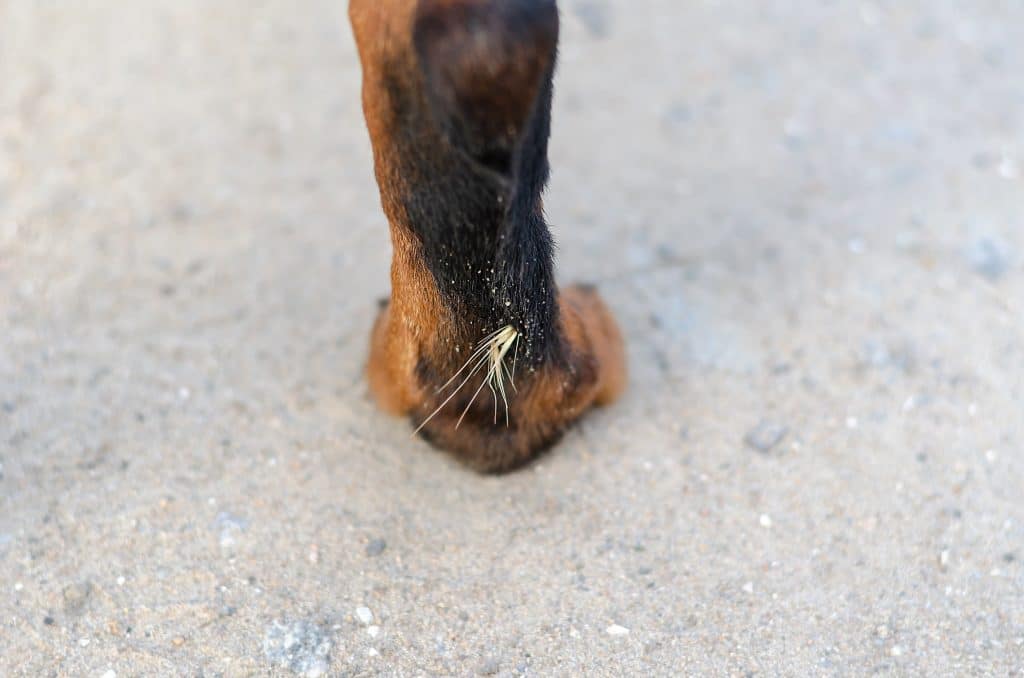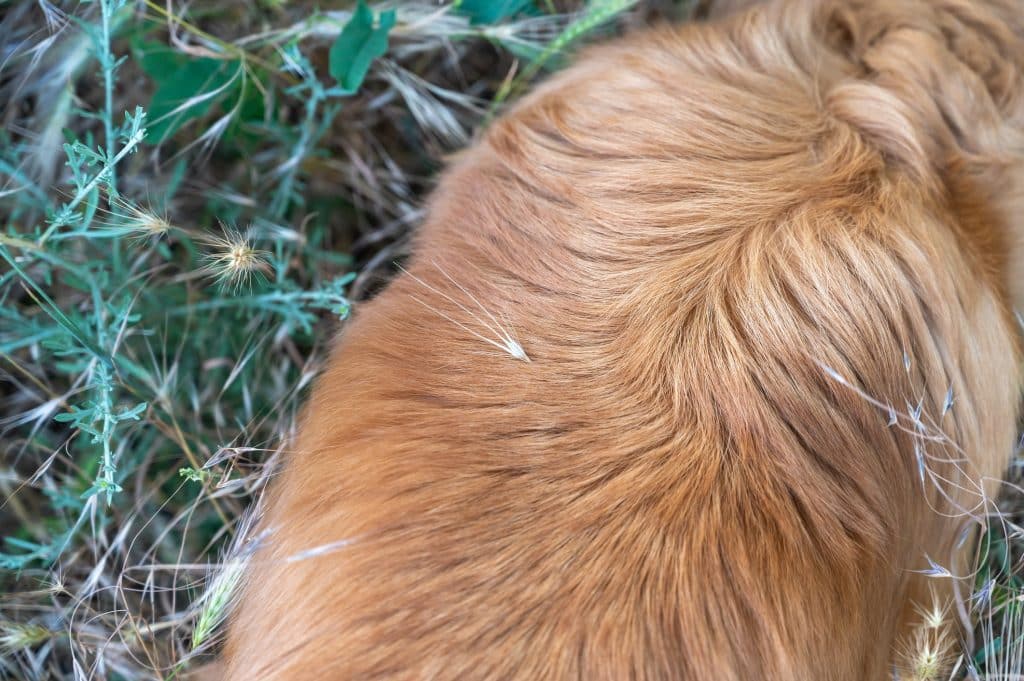- Not a substitute for professional veterinary help.
Your dog might love to explore open fields or lush woods. But during the summer, exploring and sniffing can be a risk factor for foxtails. Foxtails are invasive, prickly grasses with arrow-tailed seeds. These are found in dry regions of the United States and can lodge into your dog’s skin and fur.
“Foxtails are dangerous because of their tendency to trap themselves onto skin, noses, and respiratory tracts, where they create inflammation and irritation,” says Dr. Anita Patel, medical director with Indevets.
Patel adds that the foxtail barb’s arrow shape helps it burrow inside your dog’s body and into their skin. As a result of being stuck, foxtails can cause infections and abscesses. Thankfully, if you catch foxtails early, you can easily remove them and prevent any severe health issues.
Learn about foxtails, including where they grow, spotting one on your dog, and what to do next.
Signs Your Dog May Have an Embedded Foxtail
If your dog gets on the wrong end of a foxtail, they’ll typically show symptoms early on. For example, you may notice your dog licking more than usual as they attempt to soothe their irritated skin.
Beyond excessive licking, other signs of a foxtail, Dr. Genna Mize, DVM says, include:
- Rubbing or scratching a particular area
- The presence of a wound that doesn’t seem to heal
- Red or swollen skin
If the foxtail causes an infection or abscess in your dog, you might notice discharge, a foul odor, or even a fever. An abscess is an accumulation of pus, says Dr. Mize. She adds that the pus is caused by white blood cells responding to the foxtail and bacteria that come along with the migrating plant.
Where to Check Your Dog for Foxtails
Dr. Patel and Dr. Mize say foxtails commonly enter your dog’s body through the following points.
- Paws
- Nostrils
- Ears
- Mouth
Dr. Patel advises checking your dog’s “problem areas” immediately after a walk, so you can spot the foxtails before they can migrate deeper into their bodies. If your dog has a long coat, she suggests running your hands over their body from root to tip or using a fine-toothed comb to part their fur.
If you do find a foxtail tagging along, don’t panic. Removing them without issue is possible if you catch them early enough.

iStock/Mikhail Dmitr
How to Remove a Foxtail At Home
In some cases, you can remove foxtails yourself with good old-fashioned tweezing. Dr. Mize says that if you can easily see the foxtail, pulling it out with tweezers is okay if your dog lets you. Try to get as close to the base of the foxtail as possible so you don’t accidentally break it and leave pieces behind in your dog’s skin.
It’s also crucial to keep your dog calm during the process so they don’t jerk away. For example, if they’re anxious about you touching a sensitive area, consider distracting them with something tasty, like a spoonful of peanut butter.
When to see a vet
If the foxtail is lodged in an especially sensitive area, such as near your dog’s eye or inside their ear, it’s best to let your vet handle the removal process.
Dr. Mize suggests you should also head to a vet if you believe the foxtail may have broken and left pieces inside your dog’s body or if you see redness or swelling.
Additionally, if your dog is coughing, breathing heavily, or acting lethargic, head straight to the vet. Dr. Patel says these are all signs that a foxtail could be embedded in your dog’s respiratory tract.
How Your Vets Will Treat Foxtails
Antibiotics don’t typically help foxtails, as the infection will continue to drain until the foxtail is removed.
If your vet suspects your dog has a foxtail, they’ll likely try to find it through a physical exam or imaging scans like CTs, ultrasounds, or X-rays. According to one study on 754 dogs, vets successfully found the foxtail in nearly 73% of cases.
When foxtails are embedded deep into the skin or have migrated to another area, such as their respiratory tract, Dr. Patel says your dog will likely need surgery to remove them and treat the infected area. However, most dogs with foxtails don’t need inpatient treatment at a veterinary hospital; only a few need more serious treatments like surgery.
If the vet can’t find or remove the foxtail, they will work with you to find a long-term infection management plan. The infections from foxtails usually continuously drain, which may help your dog from feeling too sick.
While this sounds scary, here’s some good news: severe cases are rare, and outcomes are generally suitable for most dogs that visit the vet with foxtails lodged in their bodies.

iStock/Valeriia Titarenko
How to Keep Foxtails Away From Your Dog
The best way to prevent the headache of foxtails? Help your dog avoid them altogether. All types of foxtail typically bloom during summer in weedy areas with high-growing grass, such as open fields or woods.
Some ways to keep your dog from coming into contact with foxtails include the following.
- Keep the weeds in your yard trimmed through mowing or weed-whacking.
- Restrict your dog’s summer hikes to well-kept areas only.
- Trim your dog’s nails and coat so foxtails have a harder time burrowing.
- Get your dog a hoodie or sweatshirt that protects their head and ears if they’re going to explore an upgrown area.
“If you know there are foxtails present in certain areas, just don’t bring your dog there,” says Dr. Mize. You can return for fun later in the year when peak foxtail season is over.
How to recognize different types of foxtails
Three of the main foxtail species in the United States include the following. Knowing their types and appearances can help keep your dog safe while walking or hiking in the woods.
- Green Foxtail: (Setaria viridis) These foxtails have green seeds that measure anywhere from 1.8–2.2 mm (0.07-0.08 inches). You can find them throughout most of the United States.
- Yellow Foxtail: (Setaria pumila) Like the name suggests, these foxtails have a reddish-yellow appearance. Their seeds measure 2–3 mm (0.07-0.11 inches) and can be found throughout the continental United States and Canada.
- Giant Foxtail (Setaria faberi): These foxtail plants can grow over 6 feet (2 meters) tall with seeds that measure between 2.5-3 mm (0.09-0.11 inches.) You can find them from the Midwest to the East Coast and even in some West Coast states, including California.

iStock/Mikhail Dmitriev
“Foxtails are small but vicious and a force to be reckoned with,” Dr. Patel says. However, she reiterates that checking your dog after every walk or outdoor trip can help you catch foxtails before they become problematic.





